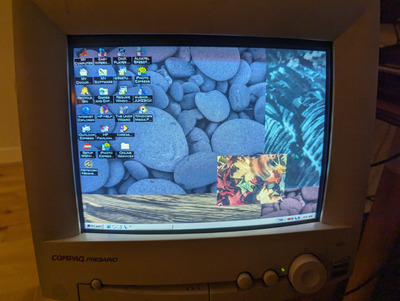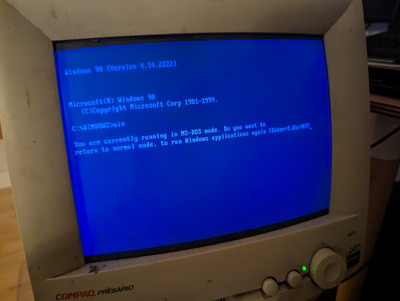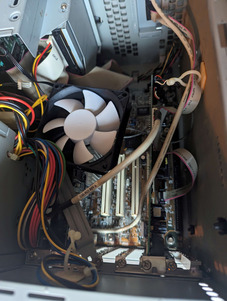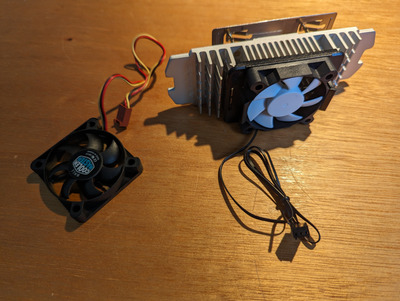Bit of a delay (to all my projects, IT or otherwise - new baby is the priority!) but this machine is running nicely, now.
I was worried it would be a real pain to get the hardware working with a fresh OS install, but I knew I wanted a better HDD (still IDE and mechanical, but a fair bit more modern and 4 x the storage at 40GB). Got Windows 98 SE on it no problem, and to my surprise after some fiddling I got the sound and game port etc all working. It took a bit of digging, but it seems this Riptide Sound/Modem thing is an HP special and it does also have an Aureal chip built into that setup. The upshot is, I was able to get it to work by finding the Riptide drivers and the Aureal drivers, then just pointing the driver installer to the required folder whenever it couldn't find e.g. an Aureal file. I'm sure I could have just combined the contents, but, it worked anyway.
The machine was also extremely loud, and it was all CPU fan so I fitted a new fan to the CPU and that is now almost silent, certainly quieter than the PSU anyway (which is itself very quite).
Strange thing happened when I was trying to get all the drivers set up - I used one of the HP updates for the optical drives. This update was for firmware and updated in DOS. This seemed to brick the drives at the time. Not visible in windows, but visible in bios and in the device manager in safe mode. Tried another known good drive - just the same. Only thing I could do in the end was another fresh install but this didn't work either, until I used FDISK to delete the partition and do a fresh install on a fresh partition, then all the drives were visible in Windows again. I don't know what happened, I was worried that I'd done something to the firmware of the drives that I wasn't going to be able to reverse - but, they are fine now.
I've also fitted a Voodoo 3. I think this was a mistake in a way because I'm realising that with my XP build which will be able to run fairly old stuff, and an early Windows 98 build, I don't really need an intermediate Windows 98 build - anything too old for XP will run on the slow 98 machine, and anything too demanding for that will run on the XP machine - at least, I'm fairly sure that will be the case for my specific uses. So, I would have been better with a PCI Voodoo card that could go in my main Windows 98 computer (I have a few processor choices for that, between 1.2 and 1.8ghz Athlon) and then the bulk of my use cases could be covered by two machines. Nevertheless, it was terrific to have it working, and quake and half life looked excellent. Another option would have been the previous motherboard which was in the middle Windows 98 machine but which is subject of the "Have I killed my motherboard" thread - I think that would have worked with the AGP voodoo. Anyway, live and learn, I think a PCI voodoo would be the more flexible option for me so something to think about in the future.
As is the way, the voodoo was very hot so I've mounted a fan with an expansion slot cover. The Voodoo now stays cool to touch (I know, not very scientific). I know that cases of this era were just so different in terms of thermals, and people used to focus on trying to create negative pressure. However, this case is especially cramped and poor for thermals, with no grills at all for additional fans front or back, and the CPU is hidden away really depending upon some exhaust via the side-mounted PSU. The one thing that this case has going for it is that it is wide and so that fan that I've added gets plenty of air from behind it, then with the expansion slots open there's somewhere for that air to go out the back. The fan is also big enough to get some airflow over the back of the card and the southbridge.
I have also modified the drive caddys and moved the HDD position a little - it was a bit of a pain pulling the front out for any changes, but now I can just just pop drives out the front individually and leave the fascia intact.
I still need to work out a solution to be able to view DOS on my main screen - I'm really space limited for pulling out an old display but it is an option when I need it.
Nice working machine, now, just some fine tuning to go and maybe another stick of RAM. It might end up being superseded if I get a glide card in the slightly faster Windows 98 machine but it's great in its own right.
Thanks for all the help - it's been great learning from people on here, lots of new things and also remembering other things I'd forgotten (and some I'd forgotten I'd forgotten).



